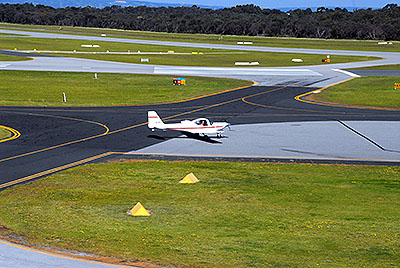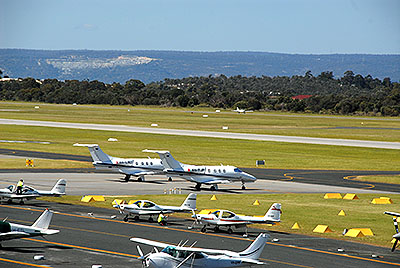Circuit procedure

Sample of students home work.
Ground
Circuit Briefing with Instructor followed by signing authorisation sheet. Sign for the headset and check maintenance release. First measure fuel quantity and order fuel if necessary. Make sure oil is within limits and engine compartment appears OK. Then drain fuel for color, water and impurities. Conduct pre-flight inspection, walk around the aircraft, scan all the body of the aircraft for damage. Check Flaps, Rudder, Ailerons, Wheels, Bolts and Nuts. Check pitot tube and static vent for obstructions.
Call for Circuit start up clearance radio call
- YPJT Ground [ Freq.124.3 ]
- JYW: Jandakot ground JYW C172 request start clearance for circuit
- YPJT Ground: JYW start approved
- JYW: Start approved JYW
Use the check list for
- Before start up
- Starting Engine
- After start up
Listen to the ATIS [ Freq.128.64 ] and call YPJT ground
- Jandakot ground [ Freq.124.3 ] JYW Dual received.... at central apron for circuits request taxi
- YPJT Ground: JYW taxi to.... and hold short RWY....
- JYW: Taxi to.... and hold short RWY.... JYW
- Taxi to requested holding point.
Taxi to run up bay, conduct memory taxi checks. Run up checks as per checklist. Don't forget PRE-TAKE-OFF SAFETY BRIEF.
Flight
- Once ready at holding point
- Change frequency to Tower 118.1 (or 119.4 for 06R 24L)
- JYW: Jandakot tower JYW ready RWY .... for ....
- Jandakot Tower: JYW Clear for take-off
- JYW: Clear for take-off JYW
- JYW: Clear for take-off
- Line Up checks: ALT - Approach clear, Landing light on, Transponder Alt 3000
- Rolling Checks: Rpm full and stable, IAS increasing, Oil t's and p's Green, Speed 60 kt, rotate
- Upwind At 300ft: Climb at speed 75 kt. UFROL - Undercarriage up/fixed, Flaps up, Rpm full and stable, Oil t's & p's green, Look out
- At 600ft Check right, centre, left, select ref. Point under the wing, turn to crosswind
- Crosswind climb up1000 ft or when downwind reached
- ASPT Level out Attitude, Speed increase until stabilise, Power reduce to 2300 Rpm, Trim
- Mixture rich, Reference point, Reference height 1000 ft Alt, Look out - Check right, centre, left, select ref. point under the wing
- 30° turn to Downwind
- Downwind
- Make sure Parallel to the RWY Downwind call: JYW: "JYW,downwind touch & go"
- Tower: "JYW,clear touch & go"
- JYW: "Clear touch & go,JYW"
- Downwind check: Brake pressure On, Undercarriage Down, Mixture Rich Hand brake released, Fuel on Both and Sufficient, Oil t's & p's in Green, Hatches & Harnesses Secure, Reference point, Reference high 1000ft, Look out - right, centre, left, select reference point, Carburator heat On, Power Reduce to 1600, Rpm confirm, if 45° to the threshold. Medium level turn (MLT) - 30° Turn to the Base.
- Base
- Hold altitude until the speed slows down to the white arc, extend 20º flaps.
- Than attitude half land / half sky on the windscreen. IAS 75kt.
- Control rate of descend to reach 700ft Altitude just before turn onto finals.
- Lookout look, right, centre, left, Turn onto finals at 700ft altitude, do not overshoot centreline.
- Final
- Maintain IAS 65 kt. Flaps 30º Carb.heat off.
- Aim for the numbers. Short final indicated airspeed 60 kt.
- At a heigh of a person Power off and flare...flare....
- Keep increasing the nose attitude until the main wheels touch the RWY first.
- DO NOT try to land by lowering the nose, but control ballooning if necessary.
After landing

- Use the first safe taxi way. (not first available) apply brakes gently if required.
- Taxi way: After landing checks. (as per the checklist)
- Radio call: YPJT Ground [ Freq.124.3 ]
- JYW: "Jandakot ground,JYW at taxi way ___request cross RWY___to central apron".
- YPJT Ground: "JYW at__cross RWY__to central apron".
- JYW: "At taxi way____crossing RWY____to central apron,JYW"
- Taxi to the central apron Shutdown check (as per the checklist)
Post flight
- Record the hours, touch & goes and landing.
- Make sure that the aircraft is tidy, secured and locked.
- Return headset. Debrief from the instructor. Record into you electronic logbook.

